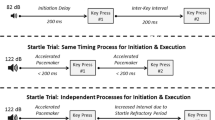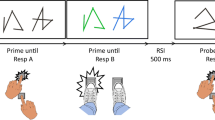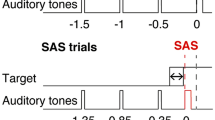Abstract
Synchronizing hand and foot movements under reactive versus predictive control results in differential timing structures between the responses. Under reactive control, where the movement is externally triggered, the electromyographic (EMG) responses are synchronized, resulting in the hand displacement preceding the foot. Under predictive control, where the movement is self-paced, the motor commands are organized such that the displacement onset occurs relatively synchronously, requiring the EMG onset of the foot to precede that of the hand. The current study used a startling acoustic stimulus (SAS), which can involuntarily trigger a prepared response, to investigate whether these results are due to differences in a pre-programmed timing structure of the responses. Participants performed synchronous movements of the right heel and right hand under both reactive and predictive modes of control. The reactive condition involved a simple reaction time (RT) task, whereas the predictive condition involved an anticipation-timing task. On selected trials, a SAS (114 dB) was presented 150 ms prior to the imperative stimulus. Results from the SAS trials revealed that while the differential timing structures between the responses was maintained under both reactive and predictive control, the EMG onset asynchrony under predictive control was significantly smaller following the SAS. These results suggest that the timing between the responses, which differs between the two control modes, is pre-programmed; however, under predictive control, the SAS may accelerate the internal timekeeper, resulting in a shortened between-limb delay.





Similar content being viewed by others
Data availability
The datasets generated during and/or analyzed during the current study are available from the corresponding author on reasonable request.
References
Bard C, Paillard J, Teasdale N et al (1991) Self-induced versus reactive triggering of synchronous hand and heel movement in young and old subjects. In: Requin J, Stelmach GE (eds) Tutorials in motor neuroscience. Springer Netherlands, Dordrecht, pp 189–196
Bard C, Paillard J, Lajoie Y et al (1992) Role of afferent information in the timing of motor commands: a comparative study with a deafferented patient. Neuropsychologia 30:201–206. https://doi.org/10.1016/0028-3932(92)90028-K
Bates D, Machler M, Bolker BM, Walker SC (2015) Fitting linear mixed-effects models using lme4. J Stat Softw 67:1–48. https://doi.org/10.18637/jss.v067.i01
Block RA, Zakay D (1996) Models of psychological time revisited. In: Helfrich H (ed) Time and mind. Hogrefe and Huber Publishers, Gottingen, pp 171–195
Blouin J-S, Bard C, Paillard J (2004) Contribution of the cerebellum to self-initiated synchronized movements: a PET study. Exp Brain Res 155:63–68. https://doi.org/10.1007/s00221-003-1709-9
Carlsen AN (2015) A broadband acoustic stimulus is more likely than a pure tone to elicit a startle reflex and prepared movements. Physiol Rep 3:e12509. https://doi.org/10.14814/phy2.12509
Carlsen AN, MacKinnon CD (2010) Motor preparation is modulated by the resolution of the response timing information. Brain Res 1322:38–49. https://doi.org/10.1016/j.brainres.2010.01.076
Carlsen AN, Maslovat D (2019) Startle and the StartReact effect: physiological mechanisms. J Clin Neurophysiol 36:452–459. https://doi.org/10.1097/WNP.0000000000000582
Carlsen AN, Dakin CJ, Chua R, Franks IM (2007) Startle produces early response latencies that are distinct from stimulus intensity effects. Exp Brain Res 176:199–205. https://doi.org/10.1007/s00221-006-0610-8
Carlsen AN, Chua R, Inglis JT et al (2009) Differential effects of startle on reaction time for finger and arm movements. J Neurophysiol 101:306–314. https://doi.org/10.1152/jn.00878.2007
Carlsen AN, Maslovat D, Lam MY et al (2011) Considerations for the use of a startling acoustic stimulus in studies of motor preparation in humans. Neurosci Biobehav Rev 35:366–376. https://doi.org/10.1016/j.neubiorev.2010.04.009
Carlsen AN, Maslovat D, Franks IM (2012) Preparation for voluntary movement in healthy and clinical populations: evidence from startle. Clin Neurophysiol 123:21–33. https://doi.org/10.1016/j.clinph.2011.04.028
Grice GR (1968) Stimulus intensity and response evocation. Psychol Rev 75:359–373
Gruber RP, Block RA (2005) Effects of caffeine on prospective duration judgements of various intervals depend on task difficulty. Hum Psychopharmacol Clin Exp 20:275–285. https://doi.org/10.1002/hup.687
Hodges PW, Bui BH (1996) A comparison of computer-based methods for the determination of onset of muscle contraction using electromyography. Electroencephalogr Clin Neurophysiol 101:511–519. https://doi.org/10.1016/S0013-4694(96)95190-5
Kuznetsova A, Brockhoff PB, Christensen RHB (2017) lmerTest package: tests in linear mixed effects models. J Stat Softw 82:1–26. https://doi.org/10.18637/jss.v082.i13
LaRue J (2007) A new methodology providing evidence of two distinct processes in the production of hand/foot simultaneous responses. Hum Mov Sci 26:757–768. https://doi.org/10.1016/j.humov.2007.07.005
Lenth RV (2020) emmeans: estimated marginal means, aka least-squares means. In: R Package Version 153. https://CRAN.R-project.org/package=emmeans. Accessed 22 Sep 2022
Leow LA, Uchida A, Egberts JL et al (2018) Triggering mechanisms for motor actions: the effects of expectation on reaction times to intense acoustic stimuli. Neuroscience 393:226–235. https://doi.org/10.1016/j.neuroscience.2018.10.008
Maslovat D, Carlsen AN, Chua R, Franks IM (2009) Response preparation changes during practice of an asynchronous bimanual movement. Exp Brain Res 195:383–392. https://doi.org/10.1007/s00221-009-1801-x
Maslovat D, Sadler CM, Smith V et al (2021) Response triggering by an acoustic stimulus increases with stimulus intensity and is best predicted by startle reflex activation. Sci Rep 11:23612. https://doi.org/10.1038/s41598-021-02825-8
Nickerson RS (1973) Intersensory facilitation of reaction time: energy summation or preparation enhancement? Psychol Rev 80:489–509
Oldfield RC (1971) The assessment and analysis of handedness: the Edinburgh inventory. Neuropsychologia 9:97–113. https://doi.org/10.1016/0028-3932(71)90067-4
Paillard J (1946) Quelques données psychophysiologiques relatives au déclenchement de la commande motrice. Année Psychol 47:28–47. https://doi.org/10.3406/psy.1946.8279
Penton-Voak IS, Edwards H, Percival A, Wearden JH (1996) Speeding up an internal clock in humans? Effects of click trains on subjective duration. J Exp Psychol Anim Behav Process 22:307–320. https://doi.org/10.1037/0097-7403.22.3.307
R Core Team (2020) R: A language and environment for statistical computing. In: R Found. Stat. Comput. https://www.r-project.org/. Accessed 22 Sep 2022
Stenneken P, Aschersleben G, Cole J, Prinz W (2002) Self-induced versus reactive triggering of synchronous movements in a deafferented patient and control subjects. Psychol Res 66:40–49. https://doi.org/10.1007/s004260100072
Acknowledgements
This work was supported by the Natural Sciences and Engineering Research Council of Canada [Grant number 2017-04717].
Author information
Authors and Affiliations
Contributions
All authors contributed to the study conception and design. Data collection and analysis were performed by AB and ANC. The first draft of the manuscript was written by AB and all authors provided revisions to previous versions of the manuscript. All authors approved the final manuscript. All authors qualify for authorship and agree to be accountable for all aspects of the work.
Corresponding author
Ethics declarations
Conflict of interest
The authors declare no relevant competing interests.
Consent to participate
Written informed consent was obtained from all individual participants included in the study.
Additional information
Communicated by Bill J Yates.
Publisher's Note
Springer Nature remains neutral with regard to jurisdictional claims in published maps and institutional affiliations.
Rights and permissions
Springer Nature or its licensor (e.g. a society or other partner) holds exclusive rights to this article under a publishing agreement with the author(s) or other rightsholder(s); author self-archiving of the accepted manuscript version of this article is solely governed by the terms of such publishing agreement and applicable law.
About this article
Cite this article
Bui, A., Maslovat, D., Lajoie, Y. et al. Investigating motor preparation in synchronous hand and foot movements under reactive vs. predictive control. Exp Brain Res 241, 1041–1052 (2023). https://doi.org/10.1007/s00221-023-06571-3
Received:
Accepted:
Published:
Issue Date:
DOI: https://doi.org/10.1007/s00221-023-06571-3




